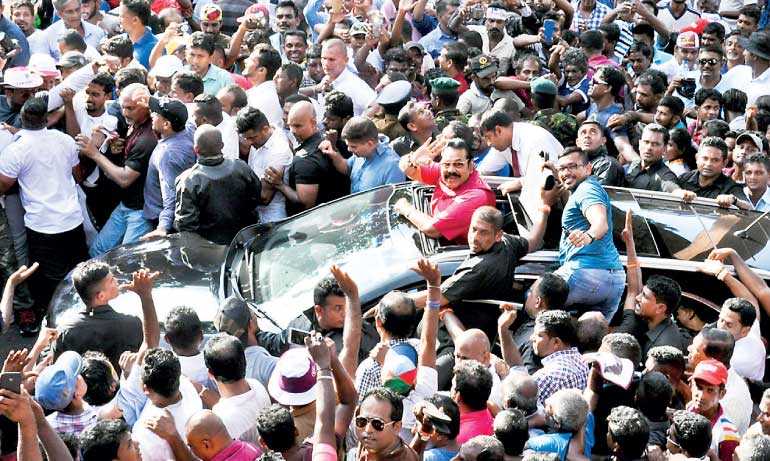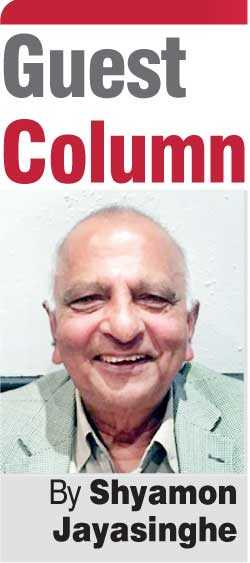Saturday Mar 15, 2025
Saturday Mar 15, 2025
Monday, 10 September 2018 00:00 - - {{hitsCtrl.values.hits}}

MP and former President Mahinda Rajapaksa at the 'Jana Balaya' protest - Pic by Lasantha Kumara
“The video of the youngster, fully intoxicated and fallen by the wayside pains my mind and reminds me of the callousness and heartlessness of projects like this led by politicians for the politicians. How could one human do this to another?”
Elite-led
The Janabalaya Colombata campaign of the JO on 5 September was essentially a mass-ferrying of humans in buses from outstations. Organised by Namal Rajapaksa and other JO leaders, the project was led and driven by a Mahinda Rajapaksa elite or coterie and remained that way until it came to a lack-lustre closure with the former President himself making an aimless and senseless speech from a vehicle. One could observe, Mahinda was tired and jaw-dropped.
It is hard to sustain a project by cajoling and rewarding people to get into buses and remain crammed up like cattle being transported. Outstation people find it uncomfortable to be away from their homes like this and let off in Colombo to fend for themselves until brought back.
If a mass protest were to be successful that has to generate from the masses themselves who perceive a compelling necessity to get mobilised and to sacrifice for a cause. An individual’s choice is generally based on a hidden processing of costs and benefits. We observed that in Arab Spring. Janabalaya Colombata was a far cry from Arab Spring. The inability to comprehend the difference in the two situations led to a wasteful exercise. The Daily Mirror editorial referred to Mahinda as a ‘sharp thinker’. Oh my God! What sharpness was that?
A well-known Sri Lankan web news editor located in London sensed the situation very well when he remarked on Facebook on the eve of Mahinda Rajapaksa’s Janabalaya: “I am going to sleep. Please call me if the Government falls!”
 Sources
Sources
One could notice what happened visibly from the numerous videos transmitted instantaneously by mobile cameras by those on the ground. Thanks to mobile phones, these days one can comment from far away of the events occurring anywhere in the world. One could even sense the emotions of people! Supplemented by independent evidence coming from other observers over there, an analysis can be completed with reasonable veracity.
The mission
The project had a serious mission to accomplish. Mahinda promised that the masses coming from different directions in the island will converge in Colombo and force the Government to quit. “We would surround Sri Lanka’s capital city, camp in the city and stay put until the Government is evicted.”
In effect the threat represented a serious breach of the constitution, which Mahinda had sworn to abide by. Our constitution lays down the procedure for a change in government and a forced physical eviction by the masses isn’t one of them. On the score of this breach itself the Government had every right to ban the procession and the meeting and even to arrest the leaders including the former President.
The Government didn’t do it because they never took the event seriously. Ranil Wickremesinghe, savvy with his vast experience, sharp with his intelligence and controlled with emotional intelligence of a high order, joked in Parliament: “Please come. You are welcome so long as you do not damage property or disrupt the lives of other citizens.” When the procession finally did enter Colombo and circuited around Lake House the Prime Minister remarked: “You can stay as long as you want. I know you will have to go back to your homes. Stay, and return as soon as possible because the Government will not fall.”
The promised outcome was never ever in sight.
Size of the crowd
There is no denying that the crowds were big but there isn’t any agreement about the size of that attendance. I guess that the selection of the Lake House roundabout as meeting centre could not have been made if the crowds had been huge like in the last May Day of the JO. In the Lake House roundabout area even a crowd of around 3,000 can impress.
A noticeable spill into outside areas was not observed in the videos I saw. The JO claim of hundreds of thousands seems a definite exaggeration. JO Member of Parliament Aluthgamage, who shines by his low incredibility, made that claim. Some videos transmitted in the internet showed the May Day Galle Face audience in order to mislead. However, Galle Face is easily identified.
On the other hand, Chathuri Dissanayake, writing to the Financial Times Daily FT (06/9), reported:
“Nearly 3,000 loyalists of former President Mahinda Rajapaksa yesterday occupied the Lake House Roundabout in Fort and held a ‘sathyagraha’ after the ‘Janabalaya Colombata’ protest march organised by the Joint Opposition (JO) was wrapped up.”
Poor coordination and pathos
Some videos taken and transmitted through mobile phones indicated that parts of crowds had gone to other spots since no clear instructions had been given. The event had not been properly coordinated.
The missing hand of Basil Rajapaksa was conspicuous. Namal Rajapaksa is said to have been the chief organiser as apparently the former President wanted him to show his metal in order to establish his credibility for Presidential candidacy. Namal hardly qualifies for that responsibility. Namal will have to go back to the working board and learn his sums.
Scattered incidents were reported of abandoned souls fallen down dead drunk. The crowds were given milk packets to drink along their march. Several are reported to have entered hospital after drinking the milk. Wimal Weerawansa counter accuses that the UNP had distributed spoilt milk! Knowing Wimal, we can let the ball pass to the wicket keeper.
One youngster from Hatton, 38 years old, had a heart attack and died. Drowning the pathos of souls lost in drink, fallen by the wayside had been the dominantly celebratory mood of large blocks of people who kept dancing and merrymaking with the Papara Papara band fully in action. Obviously the masses who attended hadn’t taken the event with the seriousness of a rebellion to overthrow the Government. They had a real go at it and returned home.
The roads were full of rubbish and Municipal officials would have had a hard time the following day cleaning and mopping up.
Spirit at the rally
This is the thing I want to say: The spirit of the people hardly evinced a seriousness or tension that rebels would necessarily exhibit. In general terms, there was no mood of potential violence, urgency or anger noticed. Nobody seemed keen to tear down the Government – except the organising elite – the Rajapaksa family and cohorts.
This is why Janabalaya could never achieve its goal of overthrowing the Government. This is why it did not evidently involve broad mass participation. The residents in Colombo themselves largely stood aloof like spectators observing a happening. Many were, however, bitter about their inability to get about normal business. Parents did not send kids to school for fear of threats to the latter’s safety. Offices largely remained closed for business. Normal civil life had come to a halt.
All for no purpose and to make space for a mad event!
A lesson for Government
I like to pause here and raise a question for the Government: Should these kinds of protests be allowed to be carried out this way with disruptive impact on peace-loving citizens? Should there be no preconditions and regulations laid down before permission is granted? For instance, the organisers had not announced the routes that were planned. This is clear violation. Routes to be taken must be announced. This would enable the police to be in readiness to ensure the protection of both protestors and civilians simultaneously. No Government can carry on in this fashion and the whole rough business drives the wrong messages to business circles. The Government wasn’t overthrown but the Government loses its hold in the public imagination in some unspeakable fashion.
Why Janabalaya remained largely trivial
There is also a lesson for the Joint Opposition: The latter got to consider why Janabalaya did not engage the population at large. The answer is simple: The people perceived no reason to join in. Janabalaya did not excite the public imagination as it was perceived as something done by a Rajapaksa elite for their benefit. Even the large numbers of supporters that Mahinda Rajapaksa still has in the country did not get stimulated by any prospect of the Government getting ousted. The fundamental thing is that this Government is in no sense an oppressive government ever ready to crush dissent. One of the principal achievements of Yahapalanaya is the liberal atmosphere and freedom of the individual that it has provided. There are no more stories of hit squads roaming about to pick and to punish arbitrarily.
I am sure, the organisers were inspired by the Arab spring. This uprising in the Middle East astonished the entire world when a volcano of human patience erupted there, taking start from Tunisia this wave of change took the neighbouring countries into its folds. In the case of these governments they were monarchies, sheikdoms or some other forms of oppressive dictatorship. Such a situation does not hold in Sri Lanka today. People in our island are conscious that there is a way to throw out an unpopular government. Janabalyas aren’t wanted unless to press for enterprise-level micro demands.
Conclusion
Thus ended a rally that wasn’t wanted by the people in the first place. The parallel to the Arab Spring stands by contrast and not by any similarity. The video of the youngster, fully intoxicated and fallen by the wayside pains my mind and reminds me of the callousness and heartlessness of projects like this led by politicians for the politicians.
How can one human do this to another?
(The writer can be reached at [email protected].)
Discover Kapruka, the leading online shopping platform in Sri Lanka, where you can conveniently send Gifts and Flowers to your loved ones for any event including Valentine ’s Day. Explore a wide range of popular Shopping Categories on Kapruka, including Toys, Groceries, Electronics, Birthday Cakes, Fruits, Chocolates, Flower Bouquets, Clothing, Watches, Lingerie, Gift Sets and Jewellery. Also if you’re interested in selling with Kapruka, Partner Central by Kapruka is the best solution to start with. Moreover, through Kapruka Global Shop, you can also enjoy the convenience of purchasing products from renowned platforms like Amazon and eBay and have them delivered to Sri Lanka.
Discover Kapruka, the leading online shopping platform in Sri Lanka, where you can conveniently send Gifts and Flowers to your loved ones for any event including Valentine ’s Day. Explore a wide range of popular Shopping Categories on Kapruka, including Toys, Groceries, Electronics, Birthday Cakes, Fruits, Chocolates, Flower Bouquets, Clothing, Watches, Lingerie, Gift Sets and Jewellery. Also if you’re interested in selling with Kapruka, Partner Central by Kapruka is the best solution to start with. Moreover, through Kapruka Global Shop, you can also enjoy the convenience of purchasing products from renowned platforms like Amazon and eBay and have them delivered to Sri Lanka.